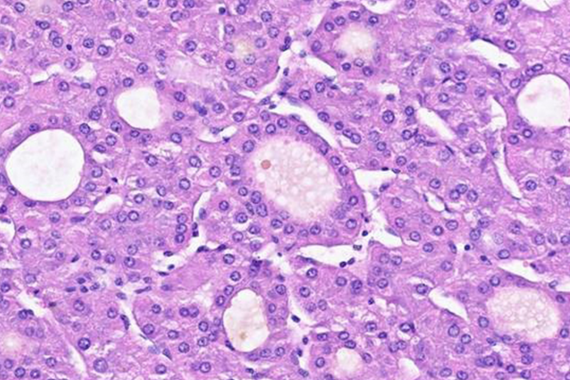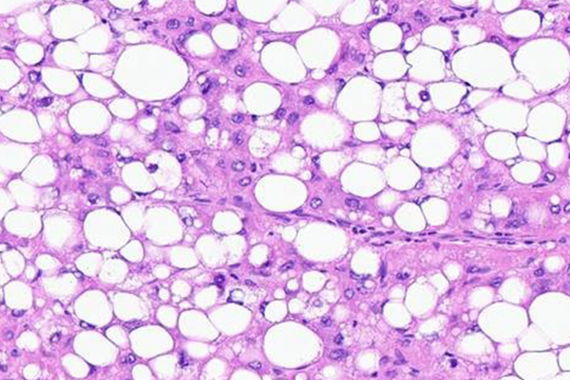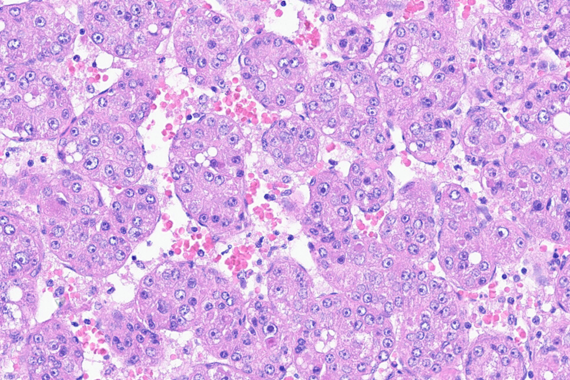-
The University
- Welcome
- Who we are
- Media & PR
- Studying
-
Research
- Profile
- Infrastructure
- Cooperations
- Services
-
Career
- Med Uni Graz as an Employer
- Educational Opportunities
- Work Environment
- Job openings
-
Diagnostics
- Patients
- Referring physicians
-
Health Topics
- Health Infrastructure
Research team Aigelsreiter
Research focus: Morpho-Molecular Liver and Pancreatic Pathology
PI: Ariane Aigelsreiter
The research team investigates histological and molecular changes in liver and pancreatic tumors, particularly hepatocellular carcinoma (HCC) and pancreatic ductal adenocarcinoma. The goal is to gain a deeper understanding of tumor biology by combining classical histopathology with modern molecular biology techniques, in order to improve prognostic assessments and develop new therapeutic strategies.
A key focus is the analysis of histomorphological alterations and their correlation with molecular pathology data. Technologies such as Next Generation Sequencing (NGS), spatial in situ hybridization and proteomic analysis are used to precisely map genetic alterations within the tissue architecture. This approach aims to identify new clinically relevant subgroups that correlate with disease progression and treatment response.
One strategy is the development of digitally annotated tumor cohorts for the application of artificial intelligence (AI). AI-based algorithms are designed to automatically detect morphological features and link them with molecular data. The aim is to improve diagnostic accuracy and to create prognostic models that support personalized therapy decisions.
In addition, the team is establishing tumor-specific organoid and cell culture models from patient-derived tumor tissue obtained during intraoperative frozen section procedures. These 3D culture systems reproduce tumor heterogeneity and histological subtypes in vitro. Organoids and cell models from HCC and pancreatic carcinomas are analyzed in terms of morphology, differentiation, and molecular characteristics, and serve as preclinical platforms for testing novel therapeutic approaches. Genetic, epigenetic and proteomic alterations are thoroughly examined to understand their impact on morphology and treatment response. The ultimate goal is to develop and validate personalized therapies based on organoid and cell culture models.
The research team bridges classical pathology and modern molecular oncology. Through digital analysis, AI-assisted morphological evaluation, and functional modeling, it aims to build a new understanding of the tumor biology of liver and pancreatic cancers—ultimately improving diagnosis, prognostic assessments, and therapeutic decisions.
Projects
Hepatocellular carcinoma – patient-specific organoid models
- As part of this translational project, patient-specific hepatocellular carcinoma (HCC) organoids are generated from tumor tissue that is removed intraoperatively during rapid section diagnostics. The organoids are established in the presence of autologous components from the serum of the respective patient in order to reconstruct the tumor microenvironment as closely as possible. The aim is to reflect the morphology and genetic changes of the primary tumor in the ex vivo cultured organoids and to create a model that is suitable for preclinical testing of individual therapeutic approaches. The tumors are morphologically subtyped according to the current WHO classification. The histological features are systematically recorded and compared with the morphological structures observed in the organoids to validate the representativeness of the models. In addition, comprehensive molecular characterization of both the primary tumor and the organoids is performed using next-generation sequencing (NGS). Relevant driver mutations and potential therapeutic targets are analyzed. By comparing the genetic profiles, it is ensured that the organoids retain the essential genetic characteristics of the original tissue. The long-term goal of the project is to establish a functional test system for personalized therapy selection. By applying various medicinal substances to patient-specific organoids, an ex vivo response can be simulated and thus the potential success of a therapy can be anticipated. This offers the prospect of making patient-specific optimized therapy decisions in the future and improving the response to targeted or systemic therapies. The combination of histopathological classification, genetic analysis, and functional testing represents an innovative approach to personalized treatment of HCC.
- Duration: 2025-2028
- Funded by: Med Uni Graz
Hepatocellular carcinoma – morpho-molecular analysis, digital pathology, and AI-supported algorithm
- As part of this project, a digital pathology cohort of patients with hepatocellular carcinoma (HCC) is being established with the aim of systematically recording morphological subtypes in accordance with the current WHO classification. The tumors will be digitized and detailed annotations of morphological heterogeneity will be made, in particular of the relative proportions of different histological growth patterns within a tumor (e.g., trabecular, pseudoglandular, solid, steatohepatitic, etc.). These quantitative morphological features are correlated with clinical endpoints such as prognosis (e.g., overall survival, disease-free survival) and response to systemic and local therapies. The morphological subtypes are further characterized by spatial in situ hybridization to analyze genetic patterns in relation to specific growth patterns. The aim is to identify genetic origins and molecular mechanisms underlying the different biological behavior of the morphological subtypes. This should enable a deeper understanding of tumor heterogeneity and contribute to the development of biologically sound stratification approaches. Based on these data, an AI-supported algorithm will be developed that automatically recognizes, quantifies, and interprets growth patterns in digital histological sections. This algorithm will be validated in future cohorts and, in the long term, used in clinical routine as a decision-making aid for personalized therapy approaches and optimized patient management. The project combines classical histopathology, digital pathology, modern image analysis, and artificial intelligence to advance precision medicine in the field of HCC.
- Duration: 2025-2028
- Funded by: Med Uni Graz
Diagnostic and Research Institute of Pathology








